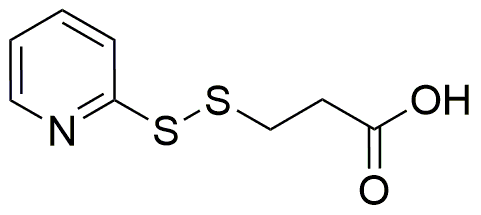3-(2-Pyridyldithio)propionic acid is widely utilized in research focused on:
- Antioxidant Formulations: This compound is effective in developing antioxidant products, helping to protect cells from oxidative stress. It's particularly valuable in the cosmetic industry for formulating anti-aging creams.
- Bioconjugation: It serves as a linker in bioconjugation processes, allowing researchers to attach biomolecules to surfaces or other molecules, enhancing drug delivery systems in pharmaceuticals.
- Analytical Chemistry: The compound is used in analytical methods to detect and quantify metal ions, making it essential in environmental monitoring and quality control in various industries.
- Polymer Chemistry: It plays a role in the synthesis of polymers with specific properties, such as improved thermal stability and mechanical strength, beneficial for materials science applications.
- Pharmaceutical Development: This chemical is explored for its potential in drug development, particularly in creating targeted therapies that can improve efficacy and reduce side effects.
General Information
Properties
Safety and Regulations
Applications
3-(2-Pyridyldithio)propionic acid is widely utilized in research focused on:
- Antioxidant Formulations: This compound is effective in developing antioxidant products, helping to protect cells from oxidative stress. It's particularly valuable in the cosmetic industry for formulating anti-aging creams.
- Bioconjugation: It serves as a linker in bioconjugation processes, allowing researchers to attach biomolecules to surfaces or other molecules, enhancing drug delivery systems in pharmaceuticals.
- Analytical Chemistry: The compound is used in analytical methods to detect and quantify metal ions, making it essential in environmental monitoring and quality control in various industries.
- Polymer Chemistry: It plays a role in the synthesis of polymers with specific properties, such as improved thermal stability and mechanical strength, beneficial for materials science applications.
- Pharmaceutical Development: This chemical is explored for its potential in drug development, particularly in creating targeted therapies that can improve efficacy and reduce side effects.
Documents
Safety Data Sheets (SDS)
The SDS provides comprehensive safety information on handling, storage, and disposal of the product.
Product Specification (PS)
The PS provides a comprehensive breakdown of the product’s properties, including chemical composition, physical state, purity, and storage requirements. It also details acceptable quality ranges and the product's intended applications.
Certificates of Analysis (COA)
Search for Certificates of Analysis (COA) by entering the products Lot Number. Lot and Batch Numbers can be found on a product’s label following the words ‘Lot’ or ‘Batch’.
Numéro de catalogue
Numéro de lot/série
Certificates Of Origin (COO)
This COO confirms the country where the product was manufactured, and also details the materials and components used in it and whether it is derived from natural, synthetic, or other specific sources. This certificate may be required for customs, trade, and regulatory compliance.
Numéro de catalogue
Numéro de lot/série
Safety Data Sheets (SDS)
The SDS provides comprehensive safety information on handling, storage, and disposal of the product.
DownloadProduct Specification (PS)
The PS provides a comprehensive breakdown of the product’s properties, including chemical composition, physical state, purity, and storage requirements. It also details acceptable quality ranges and the product's intended applications.
DownloadCertificates of Analysis (COA)
Search for Certificates of Analysis (COA) by entering the products Lot Number. Lot and Batch Numbers can be found on a product’s label following the words ‘Lot’ or ‘Batch’.
Numéro de catalogue
Numéro de lot/série
Certificates Of Origin (COO)
This COO confirms the country where the product was manufactured, and also details the materials and components used in it and whether it is derived from natural, synthetic, or other specific sources. This certificate may be required for customs, trade, and regulatory compliance.


